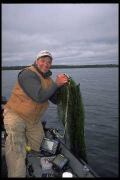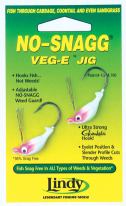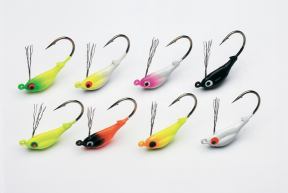X-TREME SLIP BOBBER WALLEYE RIGGING
By Mr. Slip Bobber Greg Bohn and Scott Richardson
Casting lures or jigs might help locate schools of walleyes in spring by plucking off an active one or two. But using slip bobbers to dangle live bait in front of the ‘eyes can produce massive catches even in cold water. Slip bobbers can increase your walleye catch by at least 50 percent. There are days when a jig won’t produce a fish but a slip bobber will net fish after fish.
What’s more exciting is that a handful of tackle companies led by Lindy Legendary Fishing Tackle have designed products for 2007 that will make slip bobbering so simple everyone can get in on the action. There’s never been a better time to make the move and get fired up about slip bobbering. The basics The problem many anglers have with depending on slip bobber rigs is that they tried them before new refinements made them deadly. The rigs most people remember were hit or miss at best. Years ago, a slip bobber rig consisted of nothing more than any old float, a bobber stop, a hook or a jig and some split shot to balance it all. But, that’s not close to a modern dependable rig. The wrong kind of slip shot can weaken line. The wrong float won’t slide all the way to the bobber stop, which destroys the rig’s chief asset, depth control. The wrong bobber stop can slip out of place and ruin depth control, too. Plastic stops can cut the line. Start with thread-style bobber stops. They snug tight enough to stay in place but slide enough to allow depth adjustments. They don’t nick the line like other styles can do. Trim the tag ends to about – inch long so you can tighten the knot when it needs it. Stick with a bright color stop knot and thread on a red glass bead so you can see it to be sure the float slides up to meet the stop every time. You need to know the bait is precisely where you want it to be. Lindy developed the Thill Pro Series floats (designed by Greg) that take the guesswork out of bobber choice. They come in four sizes and un-weighted or weighted designs. Each has its place. The un-weighted will support more weight below it, floats higher in the water and is perfect for calmer water. The weighted lets you cast into the wind. Casting with the wind may be easier, but once in place, your float just sits there and covers a small area.
Casting with the wind lets the bobber float back to the boat and beyond to showcase the bait to more fish over a larger section of water. The weighted bobbers also let you remove the weight when conditions change. Most importantly, the Pro Series bobbers are made with a grommit insert to let line to pass through without getting hung up. After three years of testing, they’ve never failed us once. Next add a Lindy NO-SNAGG barrel swivel. The unique design of the number 10 swivel boasts a larger loop at one end to prevent the swivel from getting stuck in the bobber and sabotaging its mission to set the depth. Tie on a 2-foot monofilament leader and a 1/32nd or 1/16th Bobber Bug (another Greg design) that add a very little weight to the hook to keep the live bait in the strike zone. The hooks are oversized to improve hooksets. And, they take big fish. (Greg had four fish over 10 pounds in 2006 all on 1/16th ounce Bobber Bug Snells and whole crawlers.)
The alternative is to use Tru-Turn Hooks in size 4 for minnows or size 6 for leeches and crawlers. Less weight at the hook allows the live bait to act naturally and lets the walleye inhale the hook along with the live bait. It’s better to use small rubber core sinkers or soft split shot a foot up the line to balance the rig. Neither weighting system will weaken the line. Add a red glass bead above the hook for even more attraction.
Lindy also has petite flicker blades that ride above the hook to add flash for attraction as they move as the bait swims. When a minnow or leech panics when they see a walleye approaching, they’ll swim harder to escape and the flicker blade sends out even more flash to trigger the strike. The good news is Lindy has taken the guesswork out of putting the rigs together with the 103-piece Thill Pro Series Slip Bobber Rig Kit. It contains 4 bobbers, two each weighted and un-weighted; thread bobber stops; glass beads; snells and Bobber Bugs in fire tiger and perch colors; and Tru-Turn hooks. The kit comes in a Plano tackle box with a $5 bonus coupon off the price of the book. Bohn keeps a dozen slip-bobber snells on a Lindy Rigger Extreme, which has eight containers inside for rubber core weights, knots, beads and everything else you need to slip-bobber fish. Using the kit, just slide on a bobber stop, a glass bead and bobber, tie one knot and you’re fishing. It’s all too easy. Best yet, the complete slip bobber rig eliminates down time rigging in the boat. We’ve all been there trying to rig slip bobbers in the boat.
Trying to re-rig after a break off in high wind and waves when the bite is on is no fun. There’s never been a better time to make the move and get fired up about slip bobbering. One word of caution; keep your Beckman net handy once you put the rig on your line, bait up and cast. You’ll need it. Lindy also offers snells alone that can be used as replacements when you need or under any bobber you prefer. Spring locations Slip bobbers are great early in the year for walleyes during prespawn, spawn and post-spawn. They are the slow antagonizing approach that seems to fit spring fishing. Rather than looking for walleyes, walleyes to come to you. They might bypass a lure, but it’s very hard for them to pass up live bait suspended a foot off the bottom with a red bead and a small blade adding to the attraction. Another advantage of slip bobbers is that they can be fished in 2 feet of water or 20 feet down. Walleyes at that time of year can be in either place. Now is the time to stick with lakes with good walleye populations that offer the chance of big fish. Avoid places with reputations as trophy waters where walleyes are relatively few. Go for the action. Look for the warmest water. Walleyes will travel miles to find water just a degree or two warmer.
Focus on rock or sand bars and protected places where wind has blown warm surface water. Fish can be found in a bay 5 feet deep, a mud flat 8 feet deep when there’s nothing there but warmer water. Emerging weeds are key. Elodia is the first plant to grow in 10 feet or water or less, and that makes it the first choice for early season walleyes. It’s like a carpet of fresh green leaves. And, it doesn’t take much. Several 5- to 6-pound walleyes have been caught off a patch no bigger than a boat and returning every day for two weeks to enjoy the same results.
Don’t overlook submerged wood, such as stump beds in 8- to 10-feet of water or less, in reservoirs. Fish may be buried in the wood. A slip bobber drifting past them will bring it out. Wind is your best friend. Water can be crystal clear early in the year. The breeze cuts light penetration so the walleyes are more active. The wind also drives bobber action, the bait moves, the flicker blade will turn. That’s what’s going to make the walleyes strike. Sometimes, the action on the slip bobbers can be so explosive you can’t do anything else than bait the hook, cast and catch. Anchor near likely spots. Set the rigs so the bait rides a foot off the bottom and cast into the wind. Never exceed 50 feet from the boat. Let the bobber float back to the boat and beyond. Twitch it a time or two before reeling to the boat to entice a strike if a walleye was watching it. If you found one fish in spring, you didn’t just find one, you just caught one, the others are right there.
We live in revolutionary times when it comes to slip bobbering. Recent improvements have taken an antique system and move it into the 21st century. The rig works every time it’s put in the water. It’s become a finely tuned and deadly walleye system.

 Early-season weed walleyes are not exclusive to America’s Northwoods. Fishermen in the nation’s Southland find spring walleyes roaming highland reservoirs over beds of moss, a kind of water hyacinth, said John Holstine, founder of the Arkansas Walleye Association.
Early-season weed walleyes are not exclusive to America’s Northwoods. Fishermen in the nation’s Southland find spring walleyes roaming highland reservoirs over beds of moss, a kind of water hyacinth, said John Holstine, founder of the Arkansas Walleye Association. BRAINERD, Minn. – Lindy Little Joe has introduced a new weed-defying jig to complement their leading NO-SNAGG line. Manufactured from a design by Greg Bohn and incorporating Lindy’s patented NO-SNAGG seven-strand wire guard, the VEG-E-JIG offers 95 percent snag-free operation in heavy vegetation, a prime feeding ground for walleye, northern pike and bass.
BRAINERD, Minn. – Lindy Little Joe has introduced a new weed-defying jig to complement their leading NO-SNAGG line. Manufactured from a design by Greg Bohn and incorporating Lindy’s patented NO-SNAGG seven-strand wire guard, the VEG-E-JIG offers 95 percent snag-free operation in heavy vegetation, a prime feeding ground for walleye, northern pike and bass.